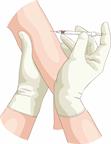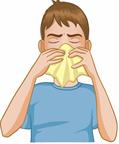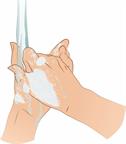Influenza, Pediatric
Influenza is also called the flu. It's an infection that affects your child's respiratory tract. This includes their nose, throat, windpipe, and lungs.
The flu is contagious. This means it spreads easily from person to person. It causes symptoms that are like a cold. It can also cause a high fever and body aches.
What are the causes?
The flu is caused by the influenza virus. Your child can get the virus by:
Breathing in droplets that are in the air after an infected person coughs or sneezes.
Touching something that has the virus on it and then touching their mouth, nose, or eyes.
What increases the risk?
Your child may be more likely to get the flu if:
They don't wash their hands often.
They're near a lot of people during cold and flu season.
They touch their mouth, eyes, or nose without first washing their hands.
They don't get a flu shot each year.
Your child may also be more at risk for the flu and serious problems, such as a lung infection called pneumonia, if:
What are the signs or symptoms?
Flu symptoms often start all of a sudden. They may last 4–14 days. Symptoms may depend on your child's age. They may include:
Fever and chills.
Headaches, body aches, or muscle aches.
Sore throat.
Cough.
Runny or stuffy nose.
Chest discomfort.
Not wanting to eat as much as normal.
Feeling weak or tired.
Feeling dizzy.
Nausea or vomiting.
How is this diagnosed?
The flu may be diagnosed based on your child's symptoms and medical history. Your child may also have a physical exam. A swab may be taken from your child's nose or throat and tested for the virus.
How is this treated?
If the flu is found early, your child can be treated with antiviral medicine. This may be given by mouth or through an IV. It can help your child feel less sick and get better faster.
The flu often goes away on its own. If your child has very bad symptoms or new problems caused by the flu, they may need to be treated in a hospital.
Follow these instructions at home:
Medicines
Eating and drinking
-
Give your child enough fluid to keep their pee pale yellow.
- Your child should drink clear fluids. These include water, ice pops that are low in calories, and fruit juice with water added to it.
- You should still breastfeed or bottle-feed your young child.
Do this in small amounts and often.
Slowly increase how much you give them.
Do not give extra water to your infant.
-
Give your child an oral rehydration solution (ORS), if told. It's a drink sold at pharmacies and stores.
-
Do not give your child drinks with a lot of sugar or caffeine in them. These include sports drinks and soda.
- If your child eats solid food, have them eat small amounts of soft foods every 3–4 hours.
Activity
How is this prevented?

-
Have your child get a flu shot every year. Ask your child's provider when your child should get a flu shot.
-
Have your child stay away from people who are sick during fall and winter. Fall and winter are cold and flu season.
Contact a health care provider if:
-
Your child gets new symptoms.
-
Your child starts to have more mucus.
- Your child has:
-
Your child isn't drinking enough fluids.
-
Your child has trouble breathing.
-
Your child starts to breathe quickly.
-
Your child's skin or nails turn blue.
-
You can't wake your child.
-
Your child gets a headache all of a sudden.
-
Your child vomits each time they eat or drink.
-
Your child has very bad pain or stiffness in their neck.
-
Your child is younger than 3 months old and has a temperature of 100.4°F (38°C) or higher.
These symptoms may be an emergency. Do not wait to see if the symptoms will go away. Call 911 right away.
This information is not intended to replace advice given to you by your health care provider. Make sure you discuss any questions you have with your health care provider.


